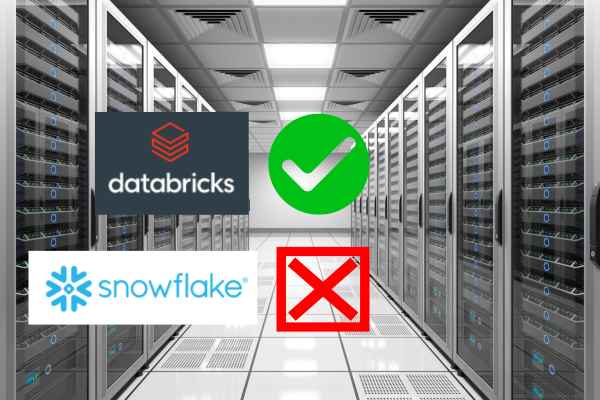While Databricks and Snowflake may seem similar at first glance, the two cloud-based platforms have distinct features, capabilities, and primary use cases that set them apart.
Databricks provides an analytics platform designed for massive-scale data engineering and collaborative data science.
Snowflake is a managed service that offers a cloud-based data warehousing platform built for easy and elastic scalability.
Despite their shared emphasis on data and cloud technology, Databricks and Snowflake offer fundamentally different solutions. This article dives into the key differences, their unique features, and what they are best used for.

Table of Contents
Differences In Company Origins
Databricks was founded in 2013 by seven of the creators of Apache Spark, a distributed computing system for big data processing.
The drawback of Spark is that the installation, configuration, and tuning present a complex process. Seven members of the Spark development team created Databricks to simplify the platform as a commercial venture. It basically provides a user-friendly GUI to manage Spark clusters.
Snowflake was co-founded in 2012 by three data warehousing experts.
The two French founders had worked for many years at Oracle and the Dutch founder had developed his own database management system. They formed Snowflake from a shared vision of a highly scalable parallel-processing database.
Databricks Has An On-Premise Option
Both Databricks and Snowflake were designed as cloud-based deployments.
When Databricks first launched, it didn’t offer an on-premise version. However, it’s possible now to deploy Databricks within a private data center.
If customers go this route, they must provide the servers, storage, and network. This is going to be more expensive than the standard cloud deployment.
Snowflake doesn’t offer an on-premise installation at all.

Both Systems Are Managed Cloud Services
Databricks is a cloud-based service, which means that you don’t install it in the traditional sense. Instead, you’ll set up an account and use the Databricks interface to configure your workspace on the cloud.
To get started with Databricks, you sign up for an account and choose a cloud provider such as AWS, Azure, or Google Cloud. Alternatively, you integrate Databricks with your existing cloud platform.
From the service provider side, Databricks manages the underlying infrastructure, including server management, software updates, and ensuring the overall availability of the Databricks service.
Similarly, when you start using Snowflake you will choose which cloud provider and platform you want for your data. You do not interact directly with the underlying cloud storage. Instead, you interact with your data through Snowflake’s SQL interface.
Snowflake as a company manages all the underlying storage details. As a user, you are responsible for managing your data within Snowflake.

Snowflake Is For Data Storage, Databricks Is Not
The main function of Snowflake is to store large volumes of data on a cloud platform. It can store structured and semi-structured data in formats such as JSON, AVRO, XML, and Parquet.
Snowflake stores data on several cloud platforms:
- S3 on AWS
- Blob Storage on Microsoft Azure
- Google Cloud Storage on GCP (Google Cloud Platform)
Unlike Snowflake, Databricks is not designed to be a primary data storage system. Instead, it’s built to integrate with and process data stored in data storage systems. That system could be Snowflake, Azure, Amazon S3, or others. This picture shows the relationship:
I should mention that Databricks has the capability to temporarily store data as part of its processing work. This includes situations like caching data for performance optimization or managing intermediate data in computations.
However, it is not meant for permanent storage.
Databricks Is Better For Complex Data Processing
While both platforms are capable of data processing, Databricks is better suited for complex and large-scale data processing needs.
Databricks is optimized for real-time analytics. It also has support for multiple programming languages, like Python, R, Scala, and SQL). These factors make it a robust choice for sophisticated data analytics.
Snowflake can also process data. However, it is primarily SQL-based and is more focused on data storage and retrieval.
Snowflake is excellent for running large SQL queries and aggregating data but is less suited for more complex data processing tasks or machine learning.

Databricks Has Inbuilt Machine Learning Functions, Snowflake Does Not
Databricks has strong machine-learning capabilities. It integrates well with ML libraries and frameworks. The platform also provides a collaborative environment for ML development and supports MLflow for experiment tracking and model deployment.
In contrast, Snowflake doesn’t offer built-in machine-learning capabilities. While it can store and query the data needed for machine learning, you typically connect Snowflake to a separate tool or platform that supports machine learning processing.
Snowflake Has An Easier Learning Curve For SQL Developers
Snowflake’s interface is SQL-based. This makes it easier to adopt if your team is already familiar with SQL e.g., your company has been running SQL Server instances for years.
Databricks uses a variety of languages like Python, R, Java, and Scala. This could have a steeper learning curve for data engineers. However, it offers more flexibility for complex data processing and machine learning tasks.
Typical Customers
There are plenty of large companies that are incorporating both Databricks and Snowflake into their technology stack.
Check out are article on who uses Databricks to see some household brand names.